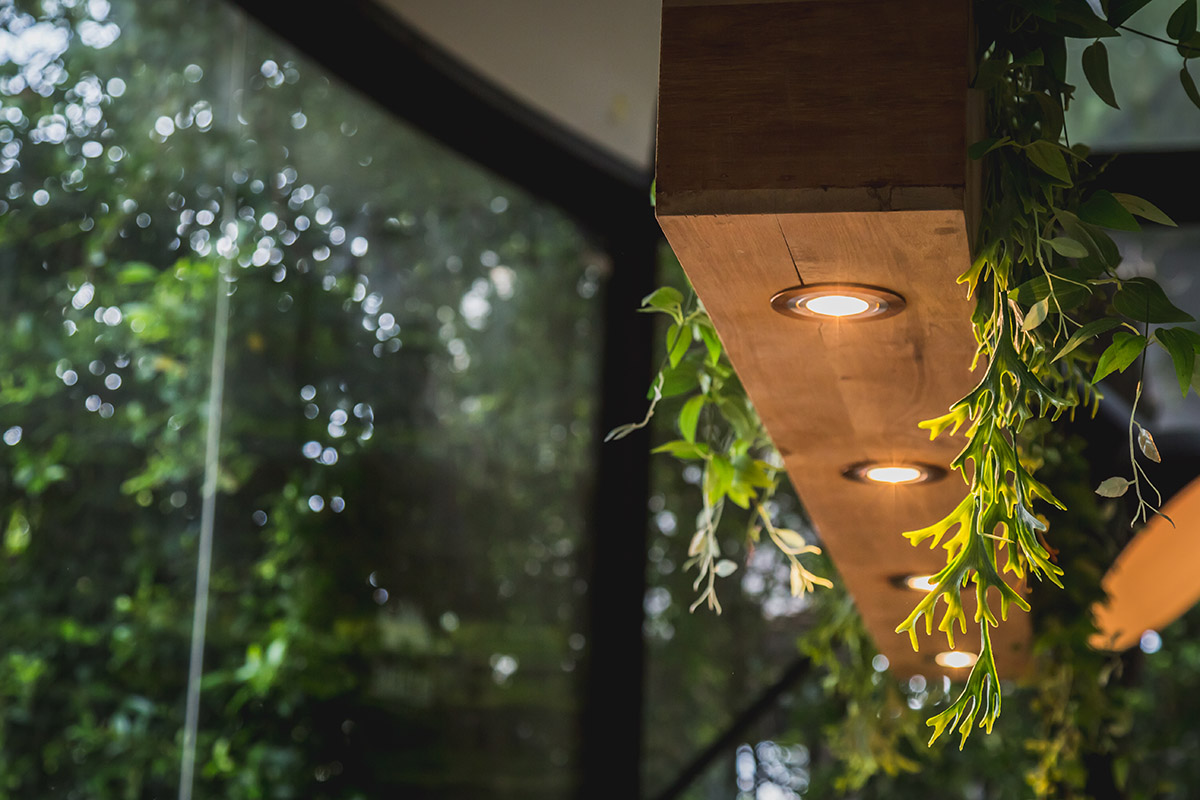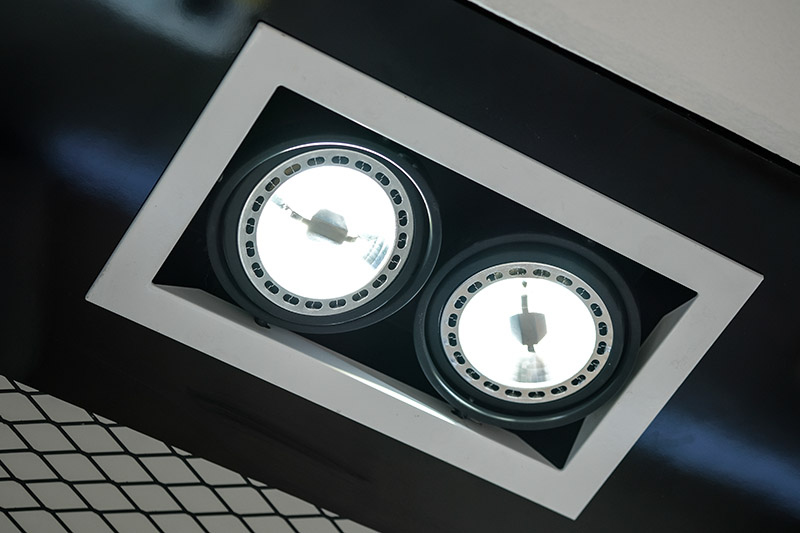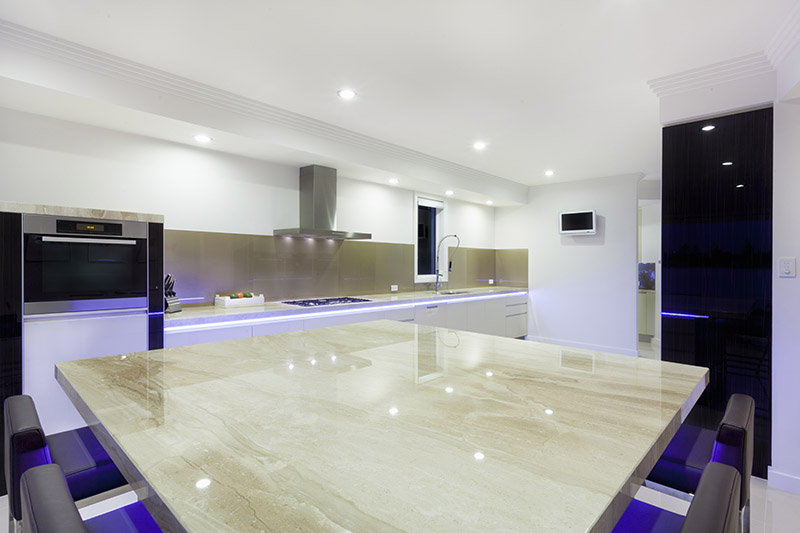A Guide to Downlights

Published: Thursday, 02 March 2023
Lighting is a significant aspect of interior design. If done effectively, it can create a light show of stunning illumination or the ability to set the mood. One of the most popular forms of lighting to improve the ambience and eco-rating of a building is downlights.
What are downlights?
Although similar to spotlights in appearance, downlights are installed into a ceiling, while spotlights are fixed onto a wall or ceiling.
Downlights are used to create different zones, navigate space and highlight key areas such as pieces of art. From providing in-fill light to task lighting over a kitchen island, this form of lighting works well to highlight impressive pieces of furniture or decor.
When buying a downlight, you can choose from fixed or directional. Fixed downlights only shine light where they have been placed, but directional downlights can be adjusted to shine into different areas of the room.
Downlights are also available in different beam sizes which allow for additional brightness, depending on how much of the room you would like to light up. Sizes include narrow, medium or wide, available in dimmable or non-dimmable.
Bezel shapes (solid flat rings that fit around the front of the light fixture, and sit flush against the ceiling to provide a neat, secure finish) are available in round, square or rectangular shapes, allowing them to match with decorative or architectural pieces. Waterproof versions are also available for outside or in your bathroom.
When being fitted you can choose from the following options:
- A trim-fitted downlight, which allows you to see the bezel on the ceiling.
- Trimless options allow for your bezel to be plastered into the ceiling - allowing for a flush finish.
- A recessed fit is where the bezel has been plastered-in or recessed into the ceiling.
- True trimless, which means your downlight is plastered in with your ceiling at the same time.

Downlight types
Recessed downlights
Recessed lights are versatile due to the fact they can be installed both on the surface and inside the ceiling wall. The main components of a recessed downlight include a trim, housing and a bulb.
Recessed downlights are one of the most popular types of low voltage downlights due to their discrete minimalistic effect - whilst also being used for task lighting, accent lighting and wall lighting.
An example includes recessed downlights being used for a bedroom to light up a bed frame, headboard or dressing table.
Surface downlights
When recessed downlights aren’t possible due to uneven ceilings or concrete structures, surface downlights may be used instead. This type of downlight is suitable for every wall and ceiling.
Surface downlights work by creating a space between the structural ceiling and the downfall ceiling.
Surface downlights are available in many designs and colours, which allows them to make an aesthetic difference in any room.
Due to them being easy to fix, they are mostly used in commercial buildings.
Pendant luminaires
This design is a hanging, uniquely shaped structure with several bulbs attached to it - the number of bulbs allows for deep and intense lighting.
They are currently one of the most glamorous kinds of downlights used for aesthetic purposes. Due to their eye-catching look, they are often used for event purposes such as weddings, birthday parties and even small gatherings.
Semi-recessed downlights
Although similar to recessed downlights, semi-recessed downlights are visible rather than being embedded inside ceilings or walls (like recessed downlights). Rather than simply lighting up a space, these downlights are more of a design feature too.

Adjustable downlights
If you are looking for interactivity when it comes to downlights, adjustable downlights could be the most compatible downlight for you.
Although slightly costly, they can be directed towards specific places and have different brightness options, sizes and shapes in order to meet specific needs.
They are particularly beneficial for larger rooms or rooms with multiple units. An example includes a kitchen downlight layout where downlights can be adjusted to shine on different kitchen units.
Exterior downlights
Otherwise known as waterproof downlights, these downlights have water-resistant features which means they won’t rust when in contact with water or moisture, making them a great choice for bathrooms, porches or outbuildings.
Some options are even available with smart features or automatic sensors - keeping the exterior of your property well-lit and protecting the house itself by alarming those who go nearby the property.
Fixed downlights
Another commonly used downlight is a fixed downlight, due to it directly pointing downwards, with lights that spread within a small diameter.
If on a budget, this downlight is ideal for you as it is one of the more cost-effective options on the market.
Fixed downlights are commonly used in smaller areas such as lounges and hallways due to their light only covering small areas.

What is a fire rated downlight?
The main difference between fire rated downlights and non fire rated lights is the amount of time it takes for the lights to stop the fire from spreading.
Fire-rated downlights work by sealing off the hole in the ceiling made during installation.
They are covered in a special coating that swells under certain temperatures and prevents flames from spreading - if this coating is not added, fire can come through the hole and potentially reach flammable materials a lot faster.
Types of downlight bulb
Downlights are usually available in a range of different bulbs depending on the brightness you need. While halogen downlights used to be widely available, they are now being slowly filtered out of UK lighting options thanks to their inefficiency, emitting significantly more unnecessary heat than their LED counterparts.
- LED downlights
While LED downlights can require a higher cost upfront, they are a much more energy-efficient option and will need to be changed less often as a result.
- Compact fluorescent light (CFL)
First invented in 1976, compact fluorescent lightbulbs were the first bulb to substitute incandescent lamps with a more sustainable solution. This type of downlight bulb is now used for ambient lighting, emergency signs and wall washing.
How many downlights do I need?
How you position downlights is dependent on the size, type, amount of components and how much light you want in the room.
For example, in a kitchen you might want to highlight the inside of cabinets; in an office the workplace area and in a hallway, just a singular piece of art.
Top tip: Never place downlights in grids as this will create wasted light. Instead, spread things out and place downlights where you need the light; this will allow you to light up larger living spaces without the need for more lighting.

Where to buy downlights
Ready to light up your life? From commercial downlights, fire rated downlights to eco-friendly LED downlights, YESSS Electrical stocks a variety of lightbulbs for your needs. Transform your space now by browsing our lighting range.

